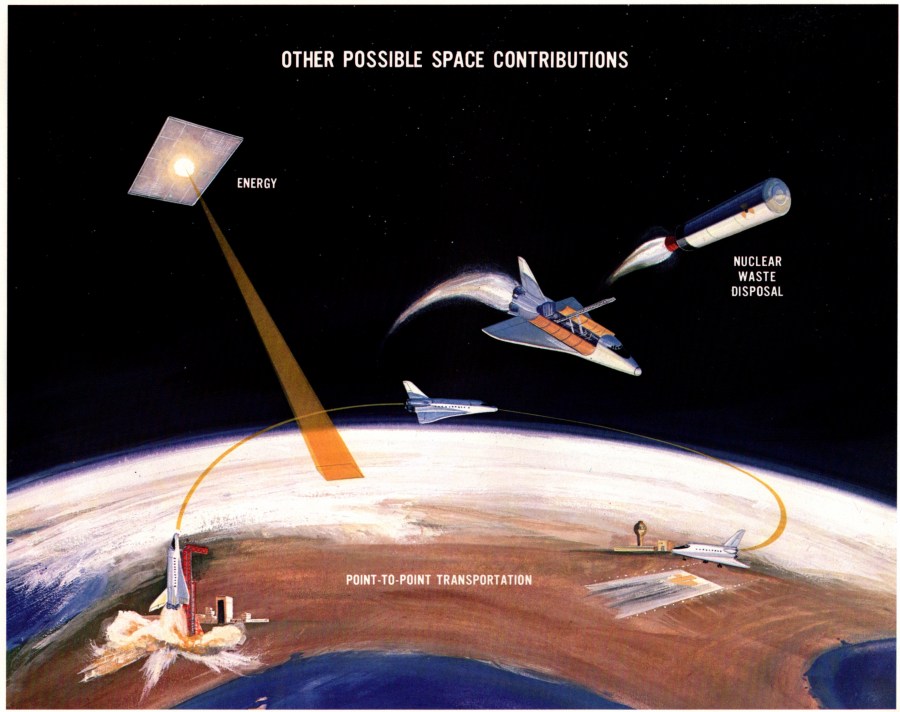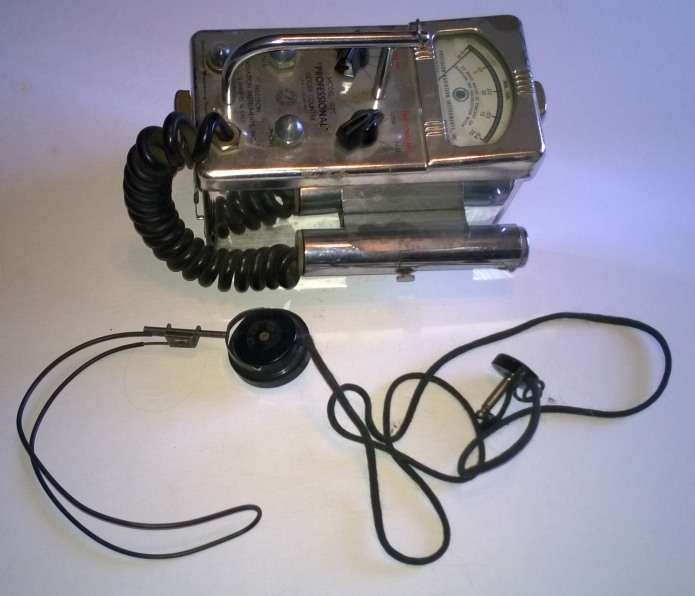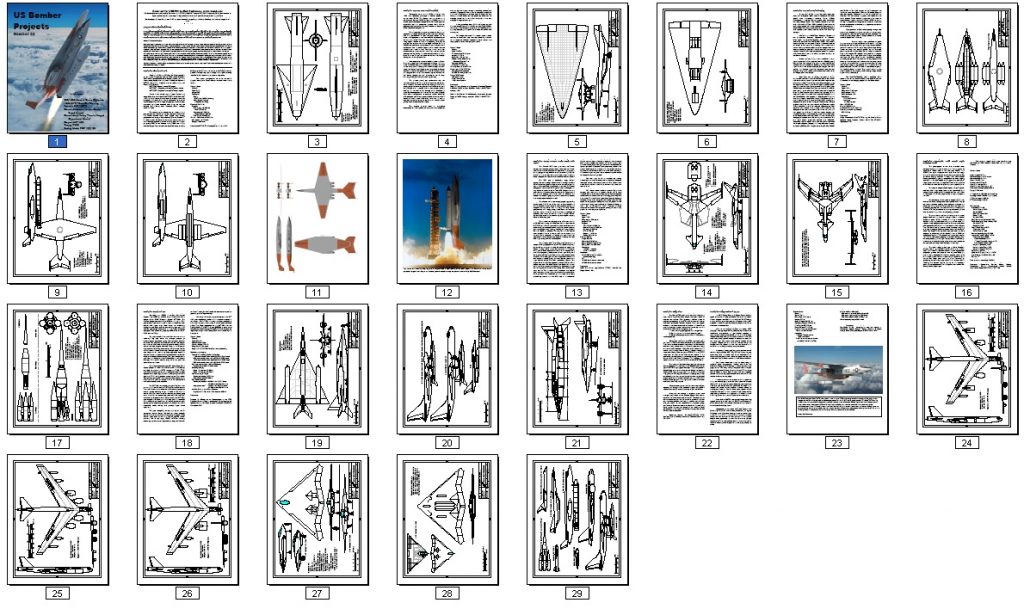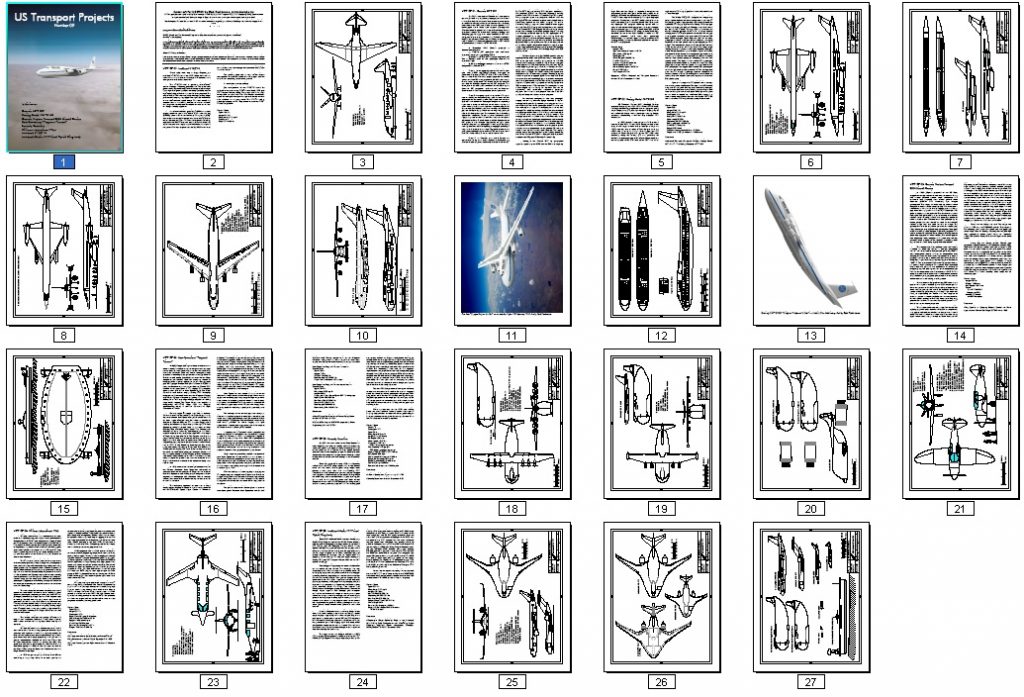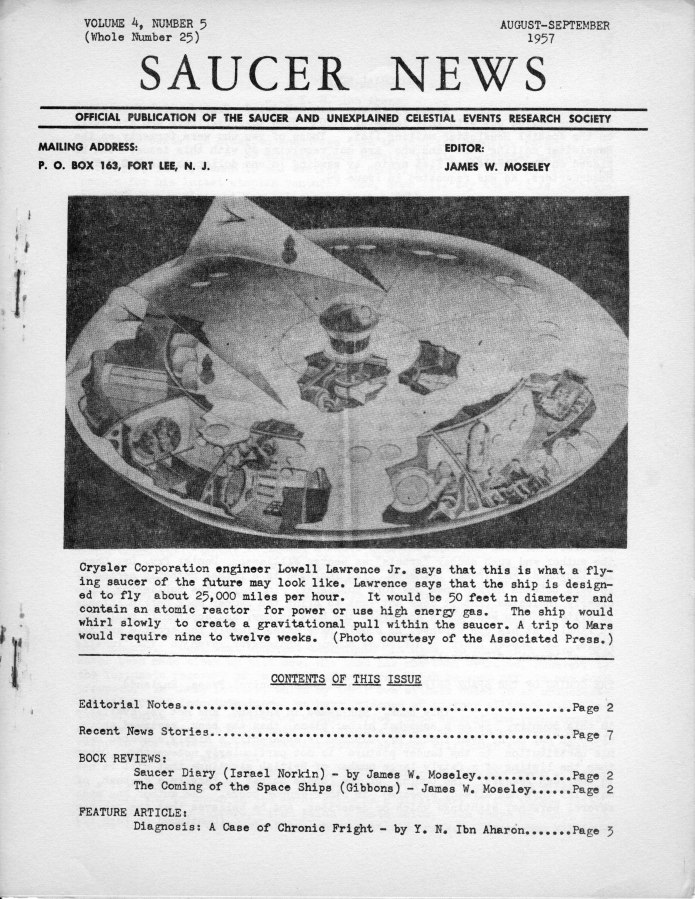Sometime around 1973/74, NASA put out a report on future aeronautics and space opportunities. While lean on technical detail, and devoid of diagrams (bah), it did have some vaguely interesting 1970’s-style art. The painting below illustrates some of the “other” things that the forthcoming Space Shuttle could do, like launch solar power satellites, lob nuclear waste into deep space and be used for point-to-point Terrestrial passenger transport. Yeah, about that…
Huh.
Koalas ‘Functionally Extinct’ After Australia Bushfires Destroy 80% Of Their Habitat
Functional extinction is when a population becomes so limited that they no longer play a significant role in their ecosystem and the population becomes no longer viable. While some individuals could produce, the limited number of koalas makes the long-term viability of the species unlikely and highly susceptible to disease.
Ruh-roh.
Australian critters always seemed to me like they were living on borrowed time. The critters from “The Old World” have spent a hundred million years competing against a wide range of other beasts, gaining superiority in arms, armor, tactics and disease resistance. Thus Old World rats and pigs and cats and dogs and snakes and rabbits and humans have done a fantastic job of ravaging Pacific islands. Australia is, compared to Africa/Eurasia, just a big island. Worse, it’s a big island that, at least for koalas, it a whole lot of lifeless sand with only a fairly limited range for koalas. Set that range on fire and send in the rats and dogs, and cute little koalas are as doomed as a village of Ewoks sent up against *competent* Stormtroopers.
Koalas have the bad luck of being dependent upon eucalyptus leaves. This is bad because eucalyptus leaves are basically filled with oil. They don’t just burn, they burn with a vengeance. I’ve seen videos of eucalyptus trees virtually *detonating* when surrounded by wildfires.
Now, as to blame: in this case, the finger points directly at the anti-nuclear activists. Imagine a world in which not only had the US not abandoned nukes, but Australia and New Zealand and the like had adopted rational nuclear polices and were now obtaining the bulk of their electrical power from breeder reactors and thorium reactors. Carbon dioxide levels in the atmosphere would be far lower, the temperature would be lower, fires would likely be less dangerous. Better, with a few extra terawatts of power on tap, Australia could at this very moment be well along in a plan to scoop out the middle of the continent and turn it into a new sea. This would open up vast tracts of desert to bloom and greatly expand the range of critters like koalas. But instead… damn dirty Soviet-backed hippies won the day and doomed koalas to functional extinction.
UPDATE: AUCTION HAS ENDED.
Here are some things that I think *should* be of considerable interest. If you are indeed interested in making a bid, send it via email to:  Buyer is responsible for postage, which for most of these can be Media Mail for low cost. Auction will end 48 hours after I put this post online. Items and photos after the break…
Buyer is responsible for postage, which for most of these can be Media Mail for low cost. Auction will end 48 hours after I put this post online. Items and photos after the break…
I have a vintage Geiger Counter. Seems to be from the 50’s or the 60’s, looks it pretty good condition, no obvious damage. Some signs of age in the chrome finish, some genuine artisanal Utah dust. I have no idea if it works, but I bet there’s a good chance that if you plugged the right batteries into it it’ll start clicking away. Comes with the headset that plugs into a jack on the upper face of the unit. Whether it works or not, it looks great as a display piece. If you are interested, it’ll go to the highest bidder, plus postage. Auction starts when this is posted, ends 48 hours later. Minimum bid, $50. If you’d like to submit a bid, email it to: 
A blog-rez photo:
Nine full-rez photos are available at the following link (should be, anyway… anyone have any trouble accessing the folder, let me know):
https://www.dropbox.com/sh/pjm2xpr0p1jf4h7/AAAFTI06RWi1W0-70Ymgh0GVa?dl=0
Behold Philco-Ford Corporation’s conception of the fantastic futuristic year 1999AD. The date isn’t given, but it’s for the Corps 75th anniversary, so circa 1967.
There is, unsurprisingly, a mix of “not even close” and “well, kinda.” Your average Dad will have spent ten years in college majoring in astrophysics and minoring in biology, and as a hobby he will genetically engineer floral abominations. In 1999, your average housewife will buy clothes and other useless crap on the computer that is connected to a wide interlinked network of other computers including various online retailers. The household computer will also have cameras all over so that the whole place is under surveillance. Banking and something akin to emails (though, oddly, handwritten) are also done on the household computer. But where this, as with many predictions, gets it wrong is the assumption that different functions will be carried out by different machines, rather than one single device that can pretty much do everything. The household sickbay is… bizarre. The remote control for the TV is *hilariously* gigantic, but at least the party where they watch the big-screen 3D TV is so awful (and full of the sort of pretentious pricks that you want to beat to death with a Louisville Slugger) it would make you want to kill yourself. Briefly shown is the Ford “Seattle-ite” concept car from 1962, which was damn near a parody of the big tailfin design ethic that had died out by the time the film was made. It was designed by Alex Tremulis and HAD A NUCLEAR POWERPLANT.
On the whole this thing comes off almost as a tie-in to “2001: A Space Odyssey.” The technology seems like it would fit squarely into that world; there’s even an almost visually identical game of computer chess played at one point.
I’ve never seen this before today, but I started having flashbacks to the 70’s when I heard the narrator voice. If you’re old enough, you too will doubtless go ‘hey, wait, I know that voice…”
ᚾᚪᛣᛚᛖᚪᚱ ᚠᚪᛣᚳᛁᚾᚷ ᚪᚪᛏᚩᛗᚩᛒᛁᛚᛖᛋ, ᛒᚪᛒᚤ!
US Bomber Projects #22 and Transport Projects #09 are now available.
US Bomber Projects #22
Cover art was provided by Rob Parthoens, www.baroba.be
US Bomber Projects #22 is now available (see HERE for the entire series). Issue #22 includes:
- GD/NASA Mach 5 Cruise Waverider: A 1990’s design very much like the “Aurora”
- NASA SR-2P Dash-On-Warning: a vertically launched ICBM carrier
- Republic MX-773B-2: a two-stage ramjet surface-to-surface missile
- Convair Subsonic Nuclear Carrier Based Aircraft: A miniature naval NX-2
- Consolidated Vultee “Parallel Staged Operational Missile:” an unusual early configuration for the Atlas ICBM
- Convair MX-1626: an early B-36-carried design leading to the B-58
- Boeing B-52X: a trie of layouts for four-engined B-52s
- Boeing Model 988-122/123: A highly maneuverable stealthy flying wing
USBP #22 can be downloaded as a PDF file for only $4.25:
——–
Don’t forget to pick up the previous issue, US Bomber Projects #21…

—
Also available:
US Transport Projects #09
Cover art was provided by Rob Parthoens, www.baroba.be
US Transport Projects #09 is now available (see HERE for the entire series). Issue #09 includes:
- Convair 58-9 SST: A design fora preliminary low-capacity test SST
- Boeing Model 757-3150: An important step in the development of the 747
- Convair Nuclear Powered GEM Aircraft Carrier: a fast long-range strike carrier
- Aero Spacelines “Pregnant Princess:” A jet-propelled Saturn rocket carrier
- Seversky Executive: A 1930’s design for a prop-powered “business jet”
- Williams International V-Jet: A 1980’s concept for a small executive transport
- Lockheed L-152-15: A very early jetliner
- Lockheed Martin 777F-sized Hybrid Wing body: A very recent large and efficient cargo transport
USTP #09 can be downloaded as a PDF file for only $4.25:
——–
—
Don’t forget the previous issue, US Transport Projects #08…

—
This image of a bit of script is floating around. I swear to Jeebus that I recognize the style; I may have even posted about it. Anybody?

LOL wut? Clown World goes nuclear:
Russian officials blame cesium exposure on ‘Fukushima crabs’
Reactor explosion? What reactor explosion? Naw, naw, see, what happened is, the guy who tested positive for elevated levels of Cesium 137 went to Thailand recently, and ate some crabs. And clearly the crabs came from Fukushima. yeah, that’s the ticket…
Hmmm.
Exclusive: Russian Doctors Say They Weren’t Warned Patients Were Nuclear Accident Victims
As more information dribbles out about the recent Russian missile explosion that released radiation of an undefined sort, this story is kinda interesting. There is some hey-didn’t-I-see-that-sort-of-thing-on-that-Chernobyl-show level paranoid bureaucracy skullduggery going on with doctors not being given all the facts, but one of the more interesting bits is that one of the doctors who treated the incident victims was found to have cesium 137 in his muscle tissue. There are a whole lot of useful bits of data left out here, such as how *much* cesium 137 and whether he could have picked it up elsewhere or whether any of the many other doctors and nurses involved were also contaminated with cesium 137. Given how often cesium 137 shows up in lower left nuclear incidents, such as industrial radioactive sources being simply lost or misplaced, it’s entirely possible that that one doctor came across it somewhere else. But if the doctor was contaminated internally to an important degree by a victim flown in from hundreds of mils from the incident site, it would indicate that there must be a *lot* of cesium 137 floating about. because cesium 137 would be an odd substance here. It’s a byproduct of the fission of U-235, but you’d imagine that uranium would be the bigger story if that was the source. It’s not seemingly terribly useful for military applications.
Cesium 137 is a beta emitter; it’s pretty much useless in a reactor, though I imagine someone clever might be able to find a way to harness the beta emissions somehow. It won;t make a bomb, though you might turn very fine powder into a cladding for a dirty bomb. Cesium salts are water soluble and play hell with biological systems since it infiltrates easily. But it’s actual practical uses in industry all seem kinda pointless for a missile:
Caesium-137 has a number of practical uses. In small amounts, it is used to calibrate radiation-detection equipment.[5] In medicine, it is used in radiation therapy.[5] In industry, it is used in flow meters, thickness gauges,[5] moisture-density gauges (for density readings, with americium-241/beryllium providing the moisture reading),[6] and in gamma ray well logging devices.[6]
I *suppose* it might have been used in a propellant flow meter for a rocket engine? Maybe?
I’m no nuclear expert, but for the life of me I can’t come up with a good use for the stuff.
Around three years ago I posted some rather cruddy images of a saucer-shaped nuclear-powered spacecraft that the Chrysler corporation drew up in 1956. At this time a manned spacecraft was a perfectly normal sort of thing for Chrysler to design; their aerospace division was responsible for the Redstone missile and the Saturn I first stage. One of the images was a small scan of the cover of the August-September 1957 issue of “Saucer News.” I finally managed to score a copy of this “fanzine”on ebay a while back and have scanned the cover at high (600 dpi) resolution. The image quality is a bit regrettable, but what can you expect from a 1950’s UFO magazine.
As always, if anyone might happen to know anything more about this design, I’m all ears. Chrysler long ago got rid of their aerospace division and whatever archive it might have had.
I have uploaded the full resolution scan to the 2019-08 APR Extras Dropbox folder, available to $4 and up subscribers to the APR Monthly Historical Documents Program.
